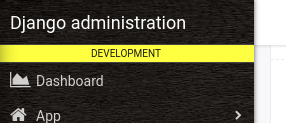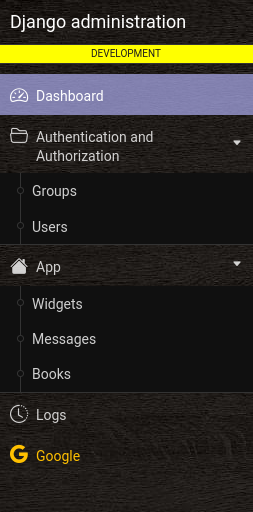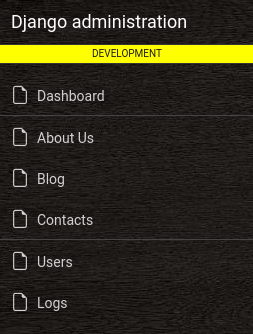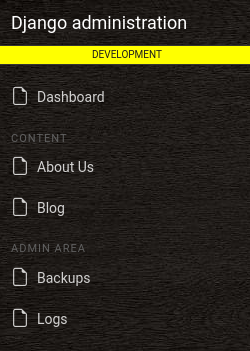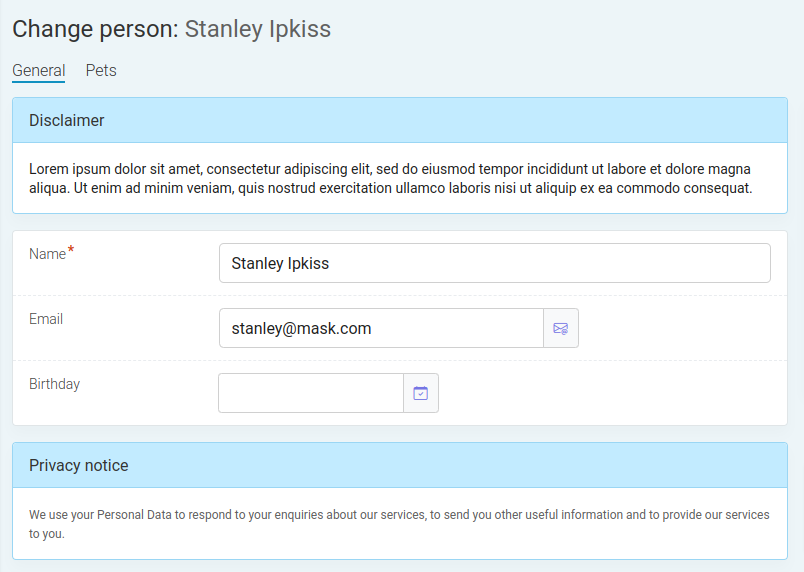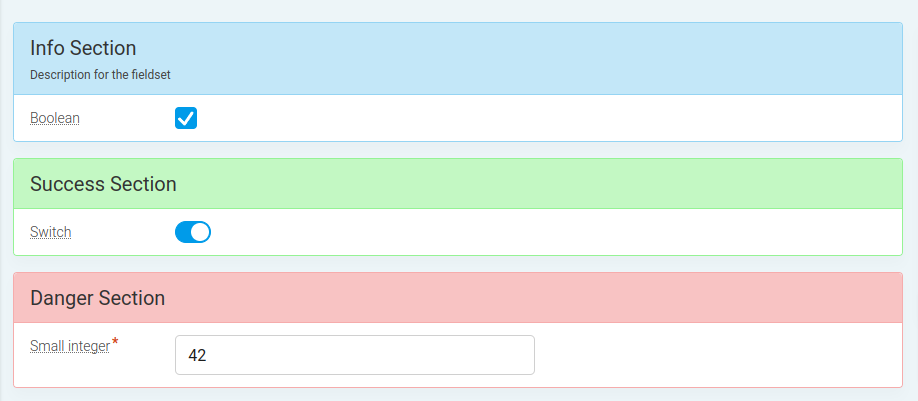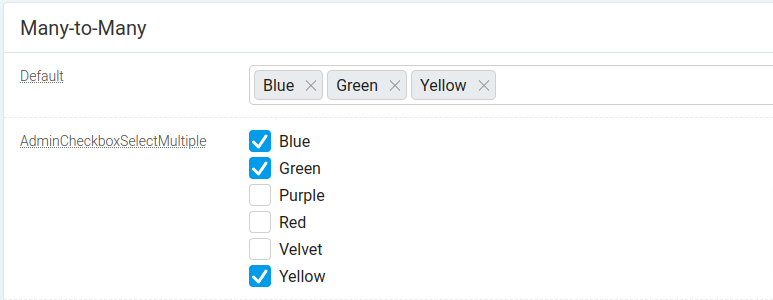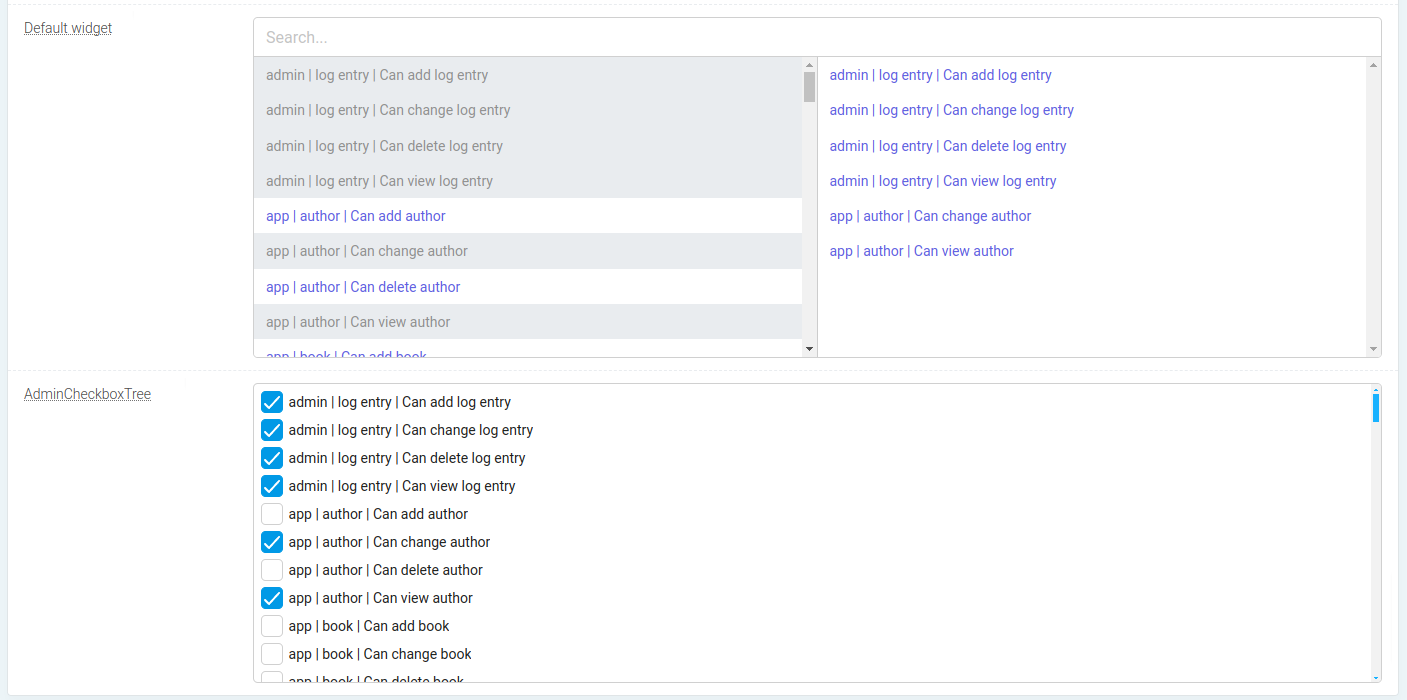Custom Django admin interface.
Project description
paper-admin
Custom Django admin interface based on Bootstrap 4.
Requirements
- Python >= 3.7
- Django >= 3.2
Table of Contents
- Installation
- Patches
- Badge
- Admin menu
- Reorderable drag-and-drop lists
- Form tabs
- Form includes
- HierarchyFilter
- Stylization
- Additional admin widgets
- Settings
- Additional References
Installation
Install the latest release with pip:
pip install paper-admin
Add paper_admin to your INSTALLED_APPS setting before django.contrib.admin.
INSTALLED_APPS = [
"paper_admin",
"paper_admin.patches.dal", # optional
"paper_admin.patches.django_money", # optional
"paper_admin.patches.django_solo", # optional
"paper_admin.patches.mptt", # optional
"paper_admin.patches.logentry_admin", # optional
"paper_admin.patches.tree_queries", # optional
# ...
"django.contrib.admin",
# ...
]
Patches
Some third-party libraries override the standard Django templates and within the paper-admin
interface look disfigured. To fix these, you can use the patches included in this package.
The following patches are available:
-
paper_admin.patches.dal
Fixes the style of the django-autocomplete-light widgets. -
paper_admin.patches.django_money
Fixes the style of the django-money widget. -
paper_admin.patches.django_solo
Fixes the breadcrumbs in django-solo. -
paper_admin.patches.mptt
Adaptation of django-mptt. Adds the ability to sort tree nodes (when thesortableproperty is specified). -
paper_admin.patches.logentry_admin
Fixes the filters and hides unwanted buttons in django-logentry-admin. -
paper_admin.patches.tree_queries
Adds the ability to sort tree nodes for django-tree-queries. It is necessary to use the specialTreeNodeModelAdminclass instead of the standardModelAdmin:# admin.py from django.contrib import admin from paper_admin.patches.tree_queries.admin import TreeNodeModelAdmin # <-- from .models import MyTreeNode @admin.register(MyTreeNode) class MyTreeNodeAdmin(TreeNodeModelAdmin): ... sortable = "position"
To use a patch, you need to add it to the INSTALLED_APPS setting.
Note: as a rule, patches should be added before the libraries they fix.
Badge
Badge is a text description of the environment to prevent confusion between the development and production servers.
The color and text of the badge can be changed in the settings.py file:
PAPER_ENVIRONMENT_NAME = "development"
PAPER_ENVIRONMENT_COLOR = "#FFFF00"
Admin menu
The paper-admin provides a way to create menus in the Django admin interface.
It allows you to define a menu tree with items that represent apps, models or custom links.
You can also define groups of items and dividers to separate them.
Usage
To use the menu system, you need to define a menu tree in your Django project's settings file. The menu tree is defined as a list of items, where each item can be either a string, a dictionary or an instance of a menu item class.
The following types of menu items are available:
Item: Represents a link to a specific URL.Divider: Represents a divider that separates items in the menu.Group: Represents a group of items in the menu.
Here's an example of a simple menu tree:
from django.utils.translation import gettext_lazy as _
from paper_admin.menu import Item, Divider
PAPER_MENU = [
Item(
label=_("Dashboard"),
url="admin:index",
icon="bi-speedometer2",
),
Divider(),
Item(
app="auth",
label=_("Authentication and Authorization"),
icon="bi-person-circle",
children=[
Item(
model="User",
icon="bi-lg bi-people",
),
Item(
model="Group",
icon="bi-lg bi-people-fill",
),
]
)
]
Item
The Item class represents a link to a specific URL. You can use it to create links
to Django admin pages, external websites or any other URL.
Properties:
app: A string representing the name of the Django app that the menu item will point to. If this is provided, the URL of the menu item will point to the app index page.model: A string representing the name of the Django model that the menu item will point to. If this is provided, the URL of the menu item will point to the model list page.label: A string representing the text that will be displayed in the menu item.url: A string representing the URL that the menu item will point to.icon: The CSS classes to use for the icon of the menu item.perms: A list of permission strings that are required for the user to see this item in the menu. If this property is not provided, the item will be visible to all users.classes: A string of additional CSS classes to add to the menu item.target: The target attribute to use for the link.children: An optional list of Item or Group instances representing sub-items of the menu item.
The app and model parameters cannot be set simultaneously. However, you must
specify at least one of the following parameters: app, model, or label.
Example usage:
from django.utils.translation import gettext_lazy as _
from paper_admin.menu import Item
PAPER_MENU = [
# Menu item with a specified label and URL
Item(
label=_("Dashboard"),
url="admin:index",
icon="bi-speedometer2",
),
# Menu for the 'auth' app. Child items will be automatically generated
# from the app's models.
Item(
app="auth"
),
# App 'app' with a specified list of models.
# The app's name is implicitly added to the model names.
Item(
app="app",
icon="bi-house-fill",
children=[
Item(
model="Widgets",
),
Item(
model="Message",
),
Item(
model="Book",
),
]
),
# Specify a model from a specific app as a child item
Item(
label=_("Logs"),
icon="bi-clock-history",
perms="admin.view_logentry",
children=[
Item(
model="admin.LogEntry",
),
]
),
# Add CSS classes and a target attribute to a link
Item(
label="Google",
url="https://google.com/",
icon="bi-google",
classes="text-warning",
target="_blank",
)
]
When defining permissions for menu items using the perms parameter, you can use
the special value superuser (changeable with PAPER_MENU_SUPERUSER_PERMISSION)
to restrict access to superusers, and staff (changeable with PAPER_MENU_STAFF_PERMISSION)
to restrict access to staff members.
Example:
from paper_admin.menu import Item
PAPER_MENU = [
Item(
app="payments",
icon="bi-money",
perms=["staff"],
children=[
Item(
model="Payment",
perms=["superuser"],
),
Item(
model="Invoice",
),
]
),
]
Divider
The Divider class is used to add a horizontal line to separate items in the menu
tree. It doesn't have any properties or methods, it's simply used to visually group
items together.
from django.utils.translation import gettext_lazy as _
from paper_admin.menu import Item, Divider
PAPER_MENU = [
Item(
label=_("Dashboard"),
url="#",
),
Divider(),
Item(
label=_("About Us"),
url="#",
),
Item(
label=_("Blog"),
url="#",
),
Item(
label=_("Contacts"),
url="#",
),
Divider(),
Item(
label=_("Users"),
url="#",
),
Item(
label=_("Logs"),
url="#",
),
]
Group
The Group class represents a group of menu items. It can be used to group related
items together under a common heading.
from django.utils.translation import gettext_lazy as _
from paper_admin.menu import Item, Group
PAPER_MENU = [
Item(
label=_("Dashboard"),
url="#",
),
Group(
label=_("Content"),
children=[
Item(
label=_("About Us"),
url="#",
),
Item(
label=_("Blog"),
url="#",
),
]
),
Group(
label=_("Admin Area"),
perms=["superuser"],
children=[
Item(
label=_("Backups"),
url="#",
),
Item(
label=_("Logs"),
url="#",
),
]
),
]
Reorderable drag-and-drop lists
The paper-admin package provides the ability to reorder items in lists using
drag-and-drop. To enable this feature, you need to set the sortable property of
the model's ModelAdmin to the name of the field that stores the order.
# models.py
from django.db import models
class Company(models.Model):
# ...
position = models.IntegerField(
"position",
default=0
)
# admin.py
from django.contrib import admin
class CompanyAdmin(admin.ModelAdmin):
# ...
sortable = "position"
https://github.com/dldevinc/paper-admin/assets/6928240/8d71f942-d222-44c6-8d4f-6f2e117bfd8d
The sorting is performed using AJAX and is saved to the database automatically.
Reorderable inline forms
The paper-admin package also provides the ability to reorder inline forms in
the same way. But in this case, the sorting is not saved to the database automatically.
from django.contrib import admin
class StaffInline(admin.StackedInline):
# ...
sortable = "position"
class IndustryInline(admin.TabularInline):
# ...
sortable = "position"
https://user-images.githubusercontent.com/6928240/125331956-b6004e80-e359-11eb-8422-832dfe37bb6c.mp4
The sorting is compatible with django-mptt
(if the paper_admin.patches.mptt patch is added to INSTALLED_APPS).
You can only change the order of elements that have the same parent and are at the same
level of nesting:
https://user-images.githubusercontent.com/6928240/125340277-55760f00-e363-11eb-94d4-49a978cb7ae4.mp4
Form tabs
The paper-admin provides a way to divide forms into sections. Sections are
represented as tabs, which makes it easier to navigate between them.
To use this feature, you need to set the tabs property of the model's
ModelAdmin to a list of tab definitions.
from django.contrib import admin
from django.utils.translation import gettext_lazy as _
class TablularInline(admin.TabularInline):
tab = 'inlines'
@admin.register(Page)
class PageAdmin(admin.ModelAdmin):
fieldsets = (
(None, {
'tab': 'related-fields',
'fields': (
# ...
),
}),
(None, {
'tab': 'standard-fields',
'fields': (
# ...
)
}),
(None, {
'tab': 'file-fields',
'fields': (
# ...
)
}),
)
tabs = [
('related-fields', _('Related fields')),
('standard-fields', _('Standard Fields')),
('file-fields', _('File Fields')),
('inlines', _('Inlines')),
]
inlines = (TablularInline, )
https://user-images.githubusercontent.com/6928240/226703428-c9413de1-42c1-4178-b75f-37412925f18f.mp4
Tabs can also be dynamically generated by the `get_tabs()` method:
from django.contrib import admin
from django.utils.translation import gettext_lazy as _
from .models import Page
@admin.register(Page)
class PageAdmin(admin.ModelAdmin):
def get_tabs(self, request, obj=None):
return [
('general', _('General')),
('content', _('Content')),
('seo', _('SEO')),
]
Form includes
paper-admin provides a convenient way to include custom templates within admin forms
at various positions, such as top, middle, or bottom. These positions correspond
to different sections of the admin form page.
Each custom form include definition can include the following parameters:
- Path to Template (Required): The path to the template you want to include within the form.
- Position (Optional): The desired position for the include. It can be one of
the following:
- "top": Above the fieldsets.
- "middle": Between the fieldsets and inlines.
- "bottom" (Default): After the inlines.
- Tab Name (Optional): If you are using Form tabs, you can specify the name of the tab where the include should be displayed.
from django.contrib import admin
from django.utils.translation import gettext_lazy as _
from ..models import Person
@admin.register(Person)
class PersonAdmin(admin.ModelAdmin):
# ...
tabs = [
("general", _("General")),
("pets", _("Pets")),
]
form_includes = [
("app/includes/disclaimer.html", "top", "general"),
("app/includes/privacy_notice.html",),
]
<!-- app/includes/privacy_notice.html -->
<div class="paper-card paper-card--info card my-3">
<div class="card-header">
<h5 class="card-title mb-0">Privacy notice</h5>
</div>
<div class="card-body">
<small class="text-secondary">
We use your Personal Data to respond to your enquiries about our services,
to send you other useful information and to provide our services to you.
</small>
</div>
</div>
Result:
In addition to the standard way of including custom templates in forms using paper-admin,
there's the capability to dynamically create includes using the get_form_includes method.
This enables you to flexibly determine which templates to include based on the current
request or other conditions.
from django.contrib import admin
from ..models import Person
@admin.register(Person)
class PersonAdmin(admin.ModelAdmin):
def get_form_includes(self, request, obj=None):
if request.user.is_superuser:
return []
return [
("app/includes/disclaimer.html", "top", "general"),
("app/includes/privacy_notice.html",),
]
HierarchyFilter
HierarchyFilter is a special type of filter that can be used to filter objects by a
hierarchical model field. It is similar to the date_hierarchy filter, but it works
with any hierarchical model field.
from django.contrib import admin
from django.utils.translation import gettext_lazy as _
from paper_admin.admin.filters import HierarchyFilter
from .models import Group, Message
class GroupFilter(HierarchyFilter):
title = _("Group")
parameter_name = "group"
def lookups(self, changelist):
return (
(pk, name)
for pk, name in Group.objects.values_list("pk", "name")
)
def queryset(self, request, queryset):
value = self.value()
if not value:
return queryset
return queryset.filter(group__in=value)
@admin.register(Message)
class MessageAdmin(admin.ModelAdmin):
# ...
list_filters = [GroupFilter]
Result:
Stylization
Table rows
You can use the get_row_classes method of the ModelAdmin
class to add custom classes to the rows in the list view.
from django.contrib import admin
from .models import Category
@admin.register(Category)
class CategoryAdmin(admin.ModelAdmin):
def get_row_classes(self, request, obj):
if obj.status == "success":
return ["table-success"]
elif obj.status == "failed":
return ["table-danger"]
return []
Fieldsets
Django provides a way to add a custom CSS classes to the fieldsets in the admin interface.
To use this feature, specify the classes parameter in the ModelAdmin.fieldsets
attribute:
from django.contrib import admin
from django.utils.translation import gettext_lazy as _
from .models import Category
@admin.register(Category)
class CategoryAdmin(admin.ModelAdmin):
fieldsets = (
(_("Info Section"), {
"classes": ("paper-card--info", ),
"description": _("Description for the fieldset"),
"fields": (
# ...
),
}),
(_("Success Section"), {
"classes": ("paper-card--success",),
"fields": (
# ...
)
}),
(_("Danger Section"), {
"classes": ("paper-card--danger",),
"fields": (
# ...
)
}),
)
Inline forms
You can use the get_form_classes method of the ModelAdmin class
to add custom classes to the inline forms:
from django.contrib import admin
class StackedInline(admin.StackedInline):
def get_form_classes(self, request, obj):
if obj.status == "success":
return ["paper-card--success"]
elif obj.status == "failed":
return ["paper-card--danger"]
return []
class TablularInlines(admin.TabularInline):
def get_form_classes(self, request, obj):
if obj.status == "success":
return ["table-success"]
elif obj.status == "failed":
return ["table-danger"]
return []
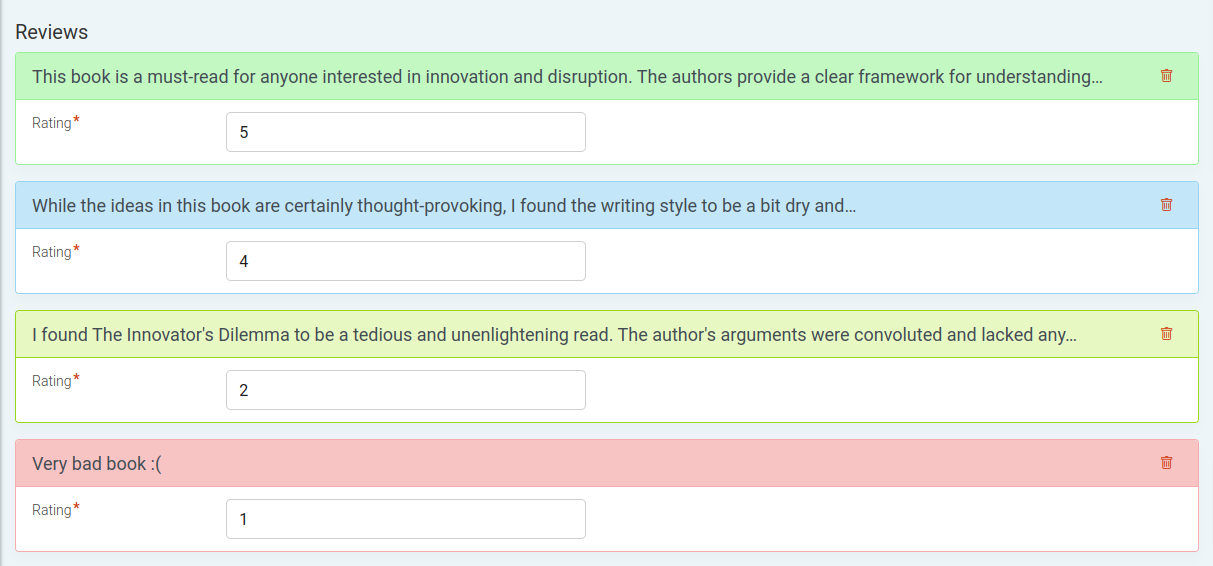
Additional Admin Widgets
You can enhance the Django admin interface with various custom widgets provided
by the paper-admin package.
AdminSwitchInput
The AdminSwitchInput widget offers a toggle switch input field for boolean fields
in the Django admin interface. This provides a more user-friendly alternative
to the default checkbox input for handling boolean values.
from django.contrib import admin
from django.db import models
from paper_admin.widgets import AdminSwitchInput
from .models import MyModel
class MyModelAdmin(admin.ModelAdmin):
formfield_overrides = {
models.BooleanField: {"widget": AdminSwitchInput},
}
admin.site.register(MyModel, MyModelAdmin)
AdminCheckboxSelectMultiple
The AdminCheckboxSelectMultiple widget improves multiple choice selection
by displaying options as checkboxes instead of a dropdown list.
AdminCheckboxTree
The AdminCheckboxTree widget presents a scrollable list of checkboxes, providing
a compact and efficient way to handle multiple selections.
# custom_users/admin.py
from django.contrib import admin
from django.contrib.auth.admin import UserAdmin
from django.contrib.auth.forms import UserChangeForm
from django.contrib.auth.models import User
from paper_admin.admin.widgets import AdminCheckboxTree
class CustomUserChangeForm(UserChangeForm):
class Meta:
widgets = {
"user_permissions": AdminCheckboxTree,
}
class CustomUserAdmin(UserAdmin):
form = CustomUserChangeForm
admin.site.unregister(User)
admin.site.register(User, CustomUserAdmin)
For permission fields, you can take it a step further and utilize paper-admin-permission-field.
Settings
PAPER_FAVICON
The path to the favicon for the admin interface.
Default: "paper_admin/dist/assets/default_favicon.png"
PAPER_ENVIRONMENT_NAME
The text of the environment badge.
Default: ""
PAPER_ENVIRONMENT_COLOR
The color of the environment badge.
Default: ""
PAPER_MENU
A list of menu items. See Admin menu for details.
Default: None
PAPER_MENU_DIVIDER
A string representing the menu item divider.
Default: "-"
PAPER_MENU_STAFF_PERMISSION
The special permission string that allows access to the menu item for staff users.
Default: "staff"
PAPER_MENU_SUPERUSER_PERMISSION
The special permission string that allows access to the menu item for superusers.
Default: "superuser"
PAPER_MENU_COLLAPSE_SINGLE_CHILDS
Whether to collapse a menu item if it has only one child.
Default: True
PAPER_DEFAULT_TAB_NAME
The name of the tab to activate in the form by default.
Default: "general"
PAPER_DEFAULT_TAB_TITLE
The title of the tab to activate in the form by default.
Default: _("General")
PAPER_LOCALE_PACKAGES
The list of packages to search for translation strings.
Default: ["paper_admin", "django.contrib.admin"]
PAPER_NONE_PLACEHOLDER
The placeholder text for the "None" option in the filters.
Default: ␀
Additional References
Project details
Release history Release notifications | RSS feed
Download files
Download the file for your platform. If you're not sure which to choose, learn more about installing packages.
Source Distribution
Built Distribution
File details
Details for the file paper_admin-7.7.1.tar.gz.
File metadata
- Download URL: paper_admin-7.7.1.tar.gz
- Upload date:
- Size: 3.5 MB
- Tags: Source
- Uploaded using Trusted Publishing? No
- Uploaded via: twine/5.1.0 CPython/3.10.12
File hashes
| Algorithm | Hash digest | |
|---|---|---|
| SHA256 |
3e31567476838a7f5e76184c9734aad48ea76a47443a09540f8839f8e24a50ee
|
|
| MD5 |
fc3018a254559453f3907192bb8fcf18
|
|
| BLAKE2b-256 |
92b126f09043b15b29a6ae9459023d4625ca58f85bff1dcfef815f8307e97c4d
|
File details
Details for the file paper_admin-7.7.1-py2.py3-none-any.whl.
File metadata
- Download URL: paper_admin-7.7.1-py2.py3-none-any.whl
- Upload date:
- Size: 3.5 MB
- Tags: Python 2, Python 3
- Uploaded using Trusted Publishing? No
- Uploaded via: twine/5.1.0 CPython/3.10.12
File hashes
| Algorithm | Hash digest | |
|---|---|---|
| SHA256 |
951b14a4f7c092fa18f783463a9f24caa346dc3cb4ecc274d52b09e20ae6fc80
|
|
| MD5 |
636b274c1b035936f50843f5ba7f6a42
|
|
| BLAKE2b-256 |
57516a44fc466584374fe9151e365fc8d8d8676922c6004216cc228a4e88c028
|





